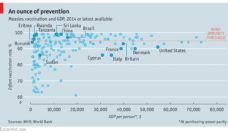Measles is a highly contagious viral disease that initially causes symptoms similar to flu, including fever, cough, runny nose, and watery eyes. Soon after symptoms begin, a rash of red spots starts on the face and spreads down the body. The virus can cause a host of complications such as ear infections and pneumonia as illness progresses. Measles can even be fatal, particularly for children under the age of five.
Measles is transmitted through respiratory droplets via coughing or sneezing and can remain infectious for hours on a contaminated surface or in the air. There is no specific antiviral treatment.
As the graph above depicts, as of August 8, 2019, there had been 1,182 confirmed cases of measles in the US. Health authorities declared that measles had been eliminated from the nation in 2000, largely resulting from the widespread vaccination program that began in 1963. However, the virus has reemerged in the US at alarmingly high rates this year. What’s driving this uptick?
Measles outbreaks in the United States generally start when a traveler is infected in another part of the world where measles is prevalent and vaccination rates are low and unknowingly carries the virus back to the US, infecting Americans who have not been vaccinated. As the map above shows, the largest number of confirmed measles cases this year have occurred in New York followed by Washington, California, Michigan, Oregon, New Jersey, and Pennsylvania where vaccine skepticism and refusal left many unprotected.
What can be done? Get vaccinated. If you’re not vaccinated, it’s extremely easy to get measles. Nine out of 10 unvaccinated people with close contact to an infected person will contract measles. Measles can be prevented with the measles, mumps, and rubella (MMR) vaccine, which is safe and effective. To increase vaccination rates following recent outbreaks, New York City is fining residents who are unvaccinated, while Washington state and California have passed laws to restrict vaccine exemptions.
Databyte via Measles Cases and Outbreaks, Centers for Disease Control and Prevention, 2019. Data visualization by David Gaitsgory.














